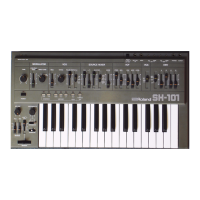SH-101
5. KEYBOARD
READ
The CPU
uses a 4 x
8
matrix
to read the number and
position of the
keys being pressed on
the keyboard,
and determines
the output priority of
the CV data and
whether new
Gate signal should
be output
according
to
the
key mode (LEGATO
or NON-LEGATO)
and the set-
tings
of the panel controls (PORTAMENTO,
ARPEG-
GIO, GATE
/TRIG, etc.)
6.
CLOCK CHECK
Any variation in the
voltage of the Clock signal
(LFO or
EXT
C LK
)
is detected
at the T1 terminal . If
a
low
Clock
signal turns high,
TR1 1 inverts it
to
low
and sends it to
the CPU, which
then performs the following
operations.
(a) Generates Random
data.
(b) Prepares the
data for Arpeggio and
Sequencer
playing.
7. RANDOM
DATA
OUTPUT
The CPU
outputs to the D/A Converter
the random data
generated and stored
in step 6(a).
8. FUNCTION SWITCH
READ
The CPU
scans all the function switches in
order to
detect any
changes made by the user. If an On/Off
change
is detected,
the CPU jumps to the appropriate
step.
Refer
to the flow chart. The
CPU can detect the On/Off
status of the HOLD
function at both the Panel button
and the
Pedal switch. When
the KEY TRANSPOSE
button is
pressed and
a
new key
selected, the CPU iden-
tifies the key that
was pressed on the keyboard and thus
identifies the
key (pitch) to
be
transposed.
9. LOAD
If
a Keyboard key,
the LEGATO (HOLD) button or the
REST
(KEY TRANSPOSE)
button is pressed, the CPU
stores that information
in the RAM, then jumps
to step
12. If no
key or button is pressed,
the CPU jumps
directly to
step
1 2.
10. PLAY
In the Play
mode, the CPU reads the Sequencer
data
stored in the RAM
and prepares both the KCV and Gate
data, then jumps
to step
1
2.
11. ARPEGGIO
If
the CPU detects during
step 6 that the Clock signal
has turned high,
the CPU prepares the KCV
data
accord-
ing
to
the order of
the key numbers stored in the
4-byte
(32 keys) Arpeggio Key Buffer, then jumps
to step 12.
If the Clock
Signal remains low, the CPU jumps directly
to step 1 2.
12. CV OUTPUT
During the Arpeggio
and Sequencer Play modes, the
CPU sends
to the D/A Converter the necessary CV data
for executing the relevant steps for Arpeggio or
Sequencer playing. During all other modes, the
TRANSPOSE Switch data (L, M or H
)
is either added to
or subtracted from the Keyboard information, and the
resulting value is sent
to
the D/A Converter. Examples of
this operation are shown below.
Transpose Switch
Position
Key
CV Data
(After
D/A Conversion)
L Lowest F 0.417V
M
Lowest
F 1.417V
H Lowest F 2.417V
H Highest
C
5.0V
13.
GATE & LED DATA OUTPUT
Port 2 of the CPU outputs the Gate, Clock Reset (CLK
RST) and LED Illumination signals. The Clock Reset
signal
resets the Clock
signal whenever
a key
on the key-
board is pressed while either the GATE/TRIG Selector
is
set to
LFO or the ARPEGGIO mode is activated. The
LED Illumination signal illuminates the LEDs above the
function switches, but does not illuminate the LEDs
for
the LFO and powerswitches.
At the end of step 1
3,
the CPU returns to
program
3
and
repeats the sequence of steps
from
3
through 13.
•
PIN CONNECTION
(Top View)
TMP80C49P
TOE
1 40
VCC(+5V}
XTAL1
E
2 39
ti
XTAL2E 3 38
P27
resetE 4 37
P26
ss 5 36
P25
INT
6 35
P24
EA 7 34
P17
rdE 8 33
P16
PSEN
E
9 32 E|P15
WR
E
10
31
p14
ALE
E
11 30
E|P13
dboE 12 29
E|P12
DB1
13 28
pi 1
DB2E 14 27
E|P10
DBS
15 26
PS
dbaE
16 25
prog
DB5E 17
24
P23
DB6
18 23
P22
DB7
19 22
P21
SS(0V)E
20
21
P20

